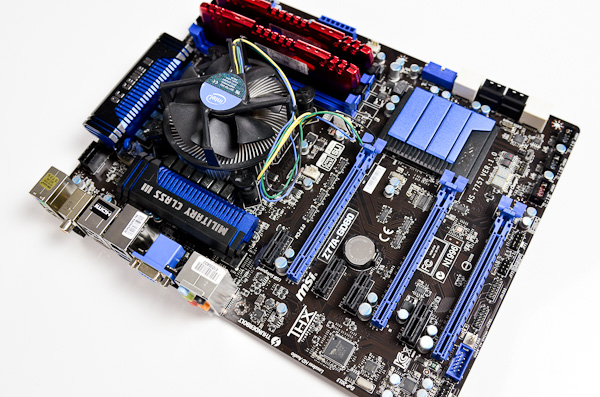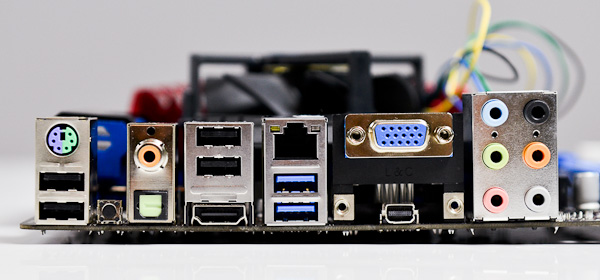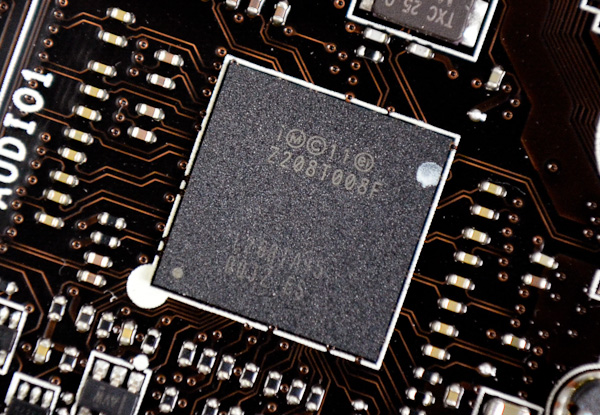A First Look at Thunderbolt on Windows with MSI's Z77A-GD80
by Anand Lal Shimpi on May 11, 2012 1:32 PM EST- Posted in
- Motherboards
- CPUs
- Intel
- MSI
- Thunderbolt
Update: Intel has informed us that we will see updated drivers for Windows certified Thunderbolt devices that will enable hot plugging under Windows as well as address some of the behavior we've seen. Intel further informed us that MSI's board has not yet made it through the certification process and a lot of these teething issues will hopefully be addressed by then.
I finally made the transition to a notebook as my desktop last year, a move many had made years prior. Quad-core mobile Sandy Bridge and good SSDs made the move simple for me, but Thunderbolt eventually made it near perfect. With only two drive bays in my notebook (I ditched my optical drive so I could have another SSD, something Brian Klug did back in 2010), there wasn't any room for good, high-performance, mass storage. Thunderbolt solved this problem for me.
Co-developed by Apple and Intel, Thunderbolt is a tunnel that carries both PCIe and DisplayPort traffic to the tune of 20Gbps per channel (10Gbps up and down). In the past, whenever you wanted to add a PCIe device (LAN, audio, high-speed storage, etc...) you needed to physically install that device in your system either via an ExpressCard slot on a notebook or via a PCIe slot on your desktop. Thunderbolt acts as a decoupler for PCIe devices, allowing you to put controllers that would traditionally lie inside your system outside of it, or even inside another device like a display. That's where the DisplayPort support comes in.
Apple's Thunderbolt Display is the perfect example of what Thunderbolt can be used to do. Take a DisplayPort panel, integrate Gigabit Ethernet, Firewire 800, audio and USB controllers and you've got Apple's Thunderbolt Display. In theory, you could connect a system that had none of these things, and the functionality would be provided exclusively by the display. Decoupling hardware like this allows OEMs to build thinner and/or smaller form factor machines (think Ultrabooks/MacBook Air), while allowing for full functionality when connected to a display. By carrying DisplayPort over the same cable, you can have a single cable that both extends functionality and connects your small form factor machine to a larger monitor. Thunderbolt enables the modern day dock for notebooks.
For all of last year, Thunderbolt was an Apple exclusive. This year, starting with the launch of Ivy Bridge, Thunderbolt is coming to PCs. We'll see it on notebooks as well as some desktop motherboards. Today we have the very first desktop motherboard with Thunderbolt support: MSI's Z77A-GD80.
Don't expect ubiquitous deployment of Thunderbolt, especially not on desktops, as the Thunderbolt controller and associated components add cost where margins are already very thin. Instead you can expect higher end motherboards to integrate it, or offer an add-in card of sorts which is the route ASUS is taking. I'd expect Ultrabooks to make better use of Thunderbolt naturally, but we will see it on desktops this year.
The Z77A-GD80 is a very full featured ATX Z77 motherboard. You get three physical PCIe x16 slots, although they are only supported in the following configurations:
| MSI Z77A-GD80 PCIe x16 Supported Configurations | ||||
| Ivy Bridge | Sandy Bridge | |||
| PCIe x16/0/0 | 1 x16 | 1 x16 | ||
| PCIe x8/8/0 | 2 x8 | 2 x8 | ||
| PCIe x8/4/4 | 1 x8 + 2 x4 | Not Supported | ||
Both CrossFire and SLI are supported.
You'll find a standard eight SATA ports on the motherboard (4 x 6Gbps, 4 x 3Gbps, 6 driven by Intel's controller). USB 3.0 comes native thanks to Intel's Z77 chipset, with two ports on the rear IO panel as well as a header and a supplied bracket for two more ports. Intel LAN comes standard as well. Audio is driven by a Realtek ALC898 controller, while VIA's VT6315N powers the on-board Firewire header.
The Star of the Show: Thunderbolt
The big news is of course the Thunderbolt port on the IO panel. Counting it, there are a total of three display outputs on the GD80, the other two are VGA and HDMI.
I believe the Thunderbolt controller on the GD80 is this little chip on the board, just behind the analog audio outputs on the IO panel. It also looks like the controller branches off of the Z77 PCH's PCIe 2.0 lanes. Although there are four PCIe x1 slots on the board, you can only use two at a time - likely because of the way the Thunderbolt controller connects to the system as it uses 4 of the 8 available PCIe 2.0 lanes. The remaining lanes aren't enough to support the on-board LAN, Firewire, audio and SATA controllers in addition to the extra PCIe slots and Thunderbolt. As a result there are limitations on what you can use in parallel (e.g. you can't use Firewire and SATA ports 7/8) in order to deal with the PCIe overprovisioning.
The markings on the Thunderbolt controller aren't familiar, so it could very well be that we're looking at Cactus Ridge - Intel's 2012 Thunderbolt controller we first heard about last year. Cactus Ridge doesn't change performance, it just helps reduce cost by integrating more functionality into the controller itself.
The beauty of Thunderbolt is it's near invisible to the OS. You don't need to install any drivers to take advantage of it, just plug your devices in and as long as your devices have driver support they'll just appear. The OS has no idea that your SATA, Ethernet or RAID controllers are sitting a few feet outside of your box, they all appear as normal PCIe devices.
As we found in our initial review of Thunderbolt on the MacBook Pro, Windows does not allow for the hot plugging of Thunderbolt devices. You can remove a Thunderbolt device once in Windows, but you cannot add a new one. Anything you want access to in Windows has to be plugged in at boot. OS X allows more flexibility in this regard as you can add/remove Thunderbolt storage and other devices while the OS is running, but even then it's not always well behaved. It's not all that uncommon to need a reboot after plugging in a chain of Thunderbolt devices under OS X, although admittedly Apple has been improving compatibility and behavior over time.
Update: Intel has informed us that we will see updated drivers for Windows certified Thunderbolt devices that will enable hot plugging under Windows. Intel further informed us that MSI's board has not yet made it through the certification process and a lot of these teething issues will hopefully be addressed by then.






















98 Comments
View All Comments
Zoomer - Friday, May 11, 2012 - link
Yeah, imagine 3TB drives on sata controllers on each of these. That's like 24 * 3TB = 72 TB. And that's without resorting to PCIE switches or SATA port multiplied.DanaGoyette - Saturday, May 12, 2012 - link
The HP Microserver is one device that could make Thunderbolt extremely useful. It has 4 drive bays (and 2 more SATA ports), but only has two low-profile PCIe slots.I'm using one of the slots for the remote access card, and the other one for a serial port card, of all things, because the remote access card is actually quite buggy.
If the Microserver had a Thunderbolt port, you could chain massive storage off the thing.
Now, what happens if you try to connect two computers together via Thunderbolt?
As for hotplug, I'd imagine the BIOS just needs to properly mark that PCIe port hotpluggable -- even Apple's own implementation doesn't do that properly.
dagamer34 - Saturday, May 12, 2012 - link
External SSD RAIDs that can easily push 1GB/sec (yes, that's gigaBTYE) which, with modern SSDs only requires 2 high end drives at this point.And while the 10Gbps v1.0 product is rather limiting, when you get to 100Gbps, that's when Thunderbolt will really shine.
repoman27 - Sunday, May 13, 2012 - link
How about if you were building a box for video production and wanted to use one of the Thunderbolt interfaces available from AJA, BlackMagic or Matrox?Although many of the Thunderbolt products that came to market in the past year were storage devices, Thunderbolt really isn't about external storage except for corner cases. You don't look at your USB ports and think that they're just there as a way to attach external disk drives, do you?
embeddedbill - Friday, May 11, 2012 - link
I'm curious, which disk was the windows OS installed on, how did that work out?apspeedbump - Friday, May 11, 2012 - link
Was an attempt made to make Windows re-initialize a hot swapped device with a utility like "Hotswap!"?It's worked, under Win 7 as well, for my computer to get drives I've plugged into external Sata to get recognized.
Just wondering it that's a feasible workaround until the drivers get certified.
peterfares - Friday, May 11, 2012 - link
I still don't understand why they needed to merge PCIe and DisplayPort, at least the way they did. If they kept everything separate, that's WAY less thunderbolt controllers everyone has to buy. If they really needed to combine with a video connector, couldn't they have just added some pins to DisplayPort or made a new connector that has both DisplayPort pins and PCIe pins? That way you could also have devices that only need the PCIe part of it without the video.Just seems like a scheme by Intel and Apple to sell unnecessary chips.
ggathagan - Friday, May 11, 2012 - link
"If they really needed to combine with a video connector, couldn't they have just added some pins to DisplayPort or made a new connector that has both DisplayPort pins and PCIe pins?"Maybe I'm not understanding your comment, but it seems very contradictory to me.
You've just described the TB connector and then have asked why someone hasn't made it.
There is only one TB contoller in each device (motherboard, display, hard drive enclosure).
You can run any protocol on it.
The fact that you can run both PCIe and DP through a single connector is a positive thing.
Why is simplifying down to a single connection for video, network, USB and firewire bad in your eyes?
repoman27 - Sunday, May 13, 2012 - link
Mini DisplayPort connectors already pack 20 pins in a 33 mm^2 cross section. That's pretty dense, there's not really room for adding more pins. Plus, by keeping the same physical connector as mini-DP, it's easier to maintain backwards compatibility with existing DisplayPort gear. Besides, more pins in the connector generally means more conductors in the cable, and Thunderbolt cables are already complex and expensive enough as is.Apple was already building Macs with this tiny little mini-DP connector that worked quite well for the form-factors they were designing, and it was capable of pushing 17.28 Gbps worth of packetized data over a single cable. Someone probably looked at that and said, "Wait a minute, why just use this for display data? Why not make it full-duplex and use it for transporting PCIe packets as well?"
As it is, you can plug DisplayPort gear into most Thunderbolt ports and just use it as if it was connected to a regular mini-DP port. Also, Intel is supposedly now shipping a much cheaper, single-channel, PCIe only variant of the Thunderbolt controller called "Port Ridge".
iSayuSay - Friday, May 11, 2012 - link
One question:From the picture, I saw Thunderbolt cable being plugged into on board TB port (which fully make sense of course). But what does it mean? Which GPU used to control the TB display?
Intel HD 4000? Or regular PCI-E GPU? If it's the latter, it means the port on GPU card become obsolete? And can we still use HDMI to be used as secondary display?
It kinda confuse me about how we use Thunderbolt on a regular tower, iMac and Macbook are integrated system so things become simple. But desktop and next gen MacPro (if it ever be updated) bring another problem since you can use PCI-E GPU which has its own display ports.
Suggestion please? Thank you